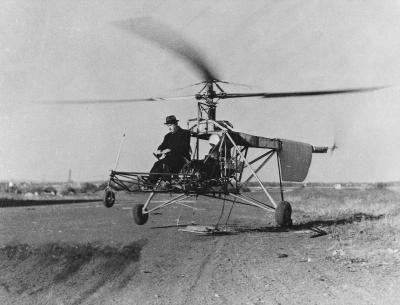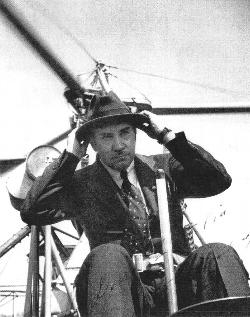First Flight Occurred 75 Years Ago
Sikorsky Aircraft this past weekend marked 75 years of modern helicopter flight that began September 14, 1939, when 50-year-old chief designer and chief test pilot Igor Sikorsky lifted off the ground to tabletop height in an experimental helicopter designated the VS-300. The first flight event began a four-year test program that proved the efficiency of Sikorsky's single rotor design, gave birth to a global helicopter industry, and forever changed the course of aviation history.

"Tens of thousands of helicopters today fly the world's skies, and the configuration almost all of them use is a single main rotor coupled to an anti-torque tail rotor. That configuration was designed and perfected by Igor Sikorsky 75 years ago," said Sikorsky President Mick Maurer. "Our most acclaimed helicopters, among them the BLACK HAWK, S-61™, CH-53, S-76® and S-92® aircraft, and many more by other manufacturers, trace their heritage to the first flight of the VS-300 aircraft. We remain immensely proud of our founder, and we recall with deep respect the fulfillment of his life-long dream to build an efficient vertical lift machine for the benefit of humankind."
Igor had tried 30 years earlier, in spring 1909, to build a helicopter at his family home in Kiev, Ukraine. His apparatus consisted of a wood and wire-braced frame built around a 25-horsepower engine connected to a transmission of wooden pulleys and belts that drove coaxial shafts topped with two twin-bladed rotors. He tried again in the spring of 1910 with a second design consisting of two new three-bladed rotors, but the craft could barely lift itself off the ground without a pilot. Realizing that technology would have to catch up with the idea of vertical lift flight, the young engineer abandoned his dream for a more practical career in fixed wing aviation.
"The helicopter was always my father's first love," said Igor's son and company ambassador Sergei Sikorsky, who worked as an apprentice mechanic on "that sweet little ship," the VS-300 aircraft. "By the late 1930s, my father wanted to prove that after two aviation careers -- in Russia before and during World War 1, and in the United States building transoceanic flying boats before the Second World War -- that he could design and build a helicopter without knowing how it should be done, and then to try to fly one never having flown one before. That was a challenge many said couldn't be done."
In 1938, Igor made a compelling argument to United Aircraft, now United Technologies Corp. The board of directors gave Igor and his team $30,000 to test his single rotor helicopter theory.

"Igor settled on a single rotor configuration for its design simplicity, and to enable the optimum placement of major components that would allow precise control of hovering take-offs and landings, and quick conversion to horizontal flight," said Mark Miller, Sikorsky Vice President of Research & Engineering. "Igor was not the first to conceive a vertical lift rotorcraft, nor did he develop any complex new technologies to ensure success. It was the genius of his design, integrating mature technologies in an innovative way, which enabled efficient vertical lift flight. Three generations later, we at Sikorsky are following a similar design approach with our next-generation X2 co-axial helicopter program."
The 1,325-pound (601 kg) max. gross weight VS-300 helicopter consisted of a welded steel tube frame with an undercarriage of three wheels. A 75-horsepower engine, transmission belts and gears drove the three-blade main rotor and single-blade counterbalanced wooden tail rotor. In flight, the main rotor turned at approximately 255 RPM.
On September 14, 1939, outside the Stratford, Connecticut, factory, Igor sat in the open VS-300 cockpit wearing his trademark overcoat and fedora, the engine vibrating the aircraft. He pulled up on the collective control lever at his left side. The VS-300 cleared the ground for a few seconds to the height of its short tether ropes. Many more such 'hops' over the ensuing days and weeks proved the aircraft could be controlled. Sikorsky and other pilots then flew different variations of the VS-300 aircraft for a total of 102 hours and 35 minutes into 1943.
Reflecting on his achievement years later, Igor Sikorsky said, "If a man is in need of rescue, an airplane can come and throw flowers on him. But a direct lift aircraft could come in and save his life."
The U.S. Army placed America's first helicopter production contract with Sikorsky in 1942 for 131 R-4 helicopters (Sikorsky designation S-47) of different variants. A YR-4A aircraft flew the first ever helicopter rescue mission under combat conditions in Burma in April, 1944.
(Images provided by Sikorsky)
 ANN's Daily Aero-Term (04.24.24): Runway Lead-in Light System
ANN's Daily Aero-Term (04.24.24): Runway Lead-in Light System ANN's Daily Aero-Linx (04.24.24)
ANN's Daily Aero-Linx (04.24.24) Aero-FAQ: Dave Juwel's Aviation Marketing Stories -- ITBOA BNITBOB
Aero-FAQ: Dave Juwel's Aviation Marketing Stories -- ITBOA BNITBOB Classic Aero-TV: Best Seat in The House -- 'Inside' The AeroShell Aerobatic Team
Classic Aero-TV: Best Seat in The House -- 'Inside' The AeroShell Aerobatic Team Airborne Affordable Flyers 04.18.24: CarbonCub UL, Fisher, Affordable Flyer Expo
Airborne Affordable Flyers 04.18.24: CarbonCub UL, Fisher, Affordable Flyer Expo




